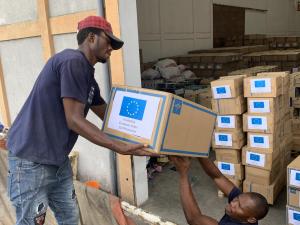The complex logistics of Ebola response
How do you deliver nearly three tons of supplies every day to halt Ebola in the Democratic Republic of the Congo’s (DRC) conflict-affected north-eastern region? For the World Health Organization (WHO), a 40-strong operations support and logistics team works almost non-stop to speedily dispatch materials across an area four times the size of neighbouring Rwanda.
Every day, 2.89 metric tons of medical and non-medical supplies and equipment leave WHO hubs in Kinshasa and in Goma, the capital of North Kivu province, to hubs in Beni and Butembo towns and five district warehouses. More than 800 vehicles, one plane, two helicopters, four trucks, 410 motorcycles (for accessing remote villages) and 37 ambulances are needed to move the supplies and team members.
Navigating insecurity, bad roads
However, operating in such a vast area which suffers regular armed attacks and insecurity is a complicated undertaking. Dilapidated roads and a hilly terrain add to the immense hurdles in supplying far-flung areas with urgently-needed materials.
“The Ebola epidemic is won by the public health response, and the field is won by the work of the logistics teams,” says Dr Abdou Salam Gueye, WHO Incident Manager for the DRC.
“As most of the difficulties we encounter are because of the environment, it tells the importance of logistics in this operation. Operations Support and Logistics (OSL) is delivering beyond WHO’s own activities as part of a concerted strategy to confine the virus and end the outbreak as soon as possible.”
Typically, WHO OSL supports at least 70% of an emergency response, comprising supply chain management, operation support and health logistics.
Between August 2018 (the beginning of the outbreak) and November 2019, WHO has shipped internationally more than 900 metric tonnes of supplies to Entebbe, Goma, Kigali and Kinshasa, all destined for the Ebola operation’s main and secondary hubs. Nearly half of the supplies were for infection and prevention control and laboratory work.
The organization has to date also delivered more than 17 million gloves, over 2 million surgical masks, 909 000 gowns and over 200 000 doses of Ebola vaccine. Put together, these supplies are equivalent in volume to nearly two Olympic-sized swimming pools. More than 1000 people have survived the virus and over 257 000 have been vaccinated.
Rapid response
In March 2019, two Ebola treatment centres torched during attacks in Butembo and Katwa towns were rebuilt in record time. The OSL teams have also constructed 11 transit centres (hosting people suspected of having Ebola), and eight Emergency Operations Centres. In partnership with the United Nations Children’s Fund (UNICEF), they install and maintain water, sanitation and hygiene equipment, drill boreholes and maintain water tanks. They handle patient waste and provide support for safe and dignified burials, a crucial part of the effort to curb the virus. In addition, OSL has built eight base camps housing 750 aid workers.
WHO works closely with the Ministry of Health and United Nations partners such as the World Food Programme and UNICEF as well as the Red Cross Red Crescent Movement in-country. OSL also supports the logistics of some partners and fills gaps when partners lack implementing capacity.
The work of WHO engineers on items such as infrastructure repairs also benefit communities beyond the Ebola response. For example, they have rebuilt a 12 km road and four bridges between two communities near Mangina that cuts travel time from four to one hour – a big win for locals seeking urgent medical help and for farmers needing to get to the market.
All hands on deck
The OSL calls on a wide range of technical skills tailored to emergency response. Typically, they include managers, supply specialists, water, sanitation and hygiene engineers, construction engineers, mechanics, cold chain experts and microbiologists. WHO also has a team of five “flying” logisticians at the ready. These troubleshooters devise solutions to specific problems, such as waste disposal, decontamination, drilling wells for potable water or getting a truck back on the road.
Transporting the Ebola vaccine at the right temperature to maintain the cold chain is a real test of ingenuity. WHO uses Arktek, a vaccine storage technology (with capacity for 120,000 doses) developed by Global Good, a collaboration between the Bill and Melinda Gates Foundation and Intellectual Ventures’ innovation lab. The “super thermos” keeps the vaccine at between -60 to -80 degrees Celsius for up to 6.5 days, and uses a tracking tool to check delivery. It was developed to transport vaccines in countries or regions prone to interruptions to the power supply or where refrigeration is not an option.
Zinedine Kada, WHO team lead for OSL in the DRC, says above all, logisticians have to anticipate and be inventive.
“People think logs is just about moving things from A to B. But whenever there is an emergency or isolated case, the logs team is right there to enable rapid public health response by providing required supplies, working conditions, means of transport and living spaces.
“We are also always thinking about the supply chain. If that is weak, our programmes will be weak and we will have failed in our purpose of providing support and emergency care for those in need.”
WHO logistics operations in the DRC is supported by the European Commission Humanitarian Aid (ECHO).



